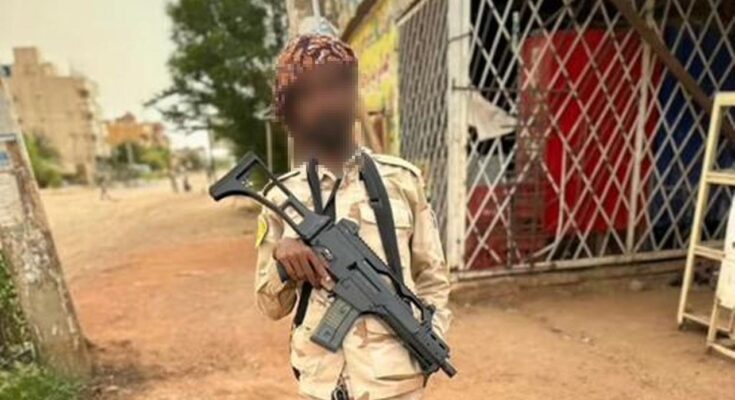exclusive
The RSF militia is waging a brutal war in Sudan, reportedly using European weapons. Photographic evidence evaluated by the Mainz Report shows that the militia possessed German weapons.
This relief can be seen at Mahawib Yahya. The young woman sits in front of one of the many white tents in the Allafad refugee camp in northern Sudan. Their home area around the town of Al-Fashir has been under siege and bombardment for weeks. Yahya said he no longer believed he could survive. “In the end there was nothing left to eat. All that was left was animal food. Then we ate feathers.”
Forces called the Rapid Support Forces (RSF) have surrounded Al-Fashir for months. Rebel militias have been engaged in a brutal civil war with the Sudanese army for more than two years. War opponents used to be allies, then the struggle for power escalated.
War observers have accused the RSF militia of committing serious atrocities since Al-Fashir’s capture. Videos shared on the Internet showed RSF fighters grinning in front of piles of corpses, and random shooting was also visible. The images and videos also show that the militia appears to be heavily armed.
“It is clear that troops in Sudan are receiving steady supplies, by air and by land,” said Mike Lewis. The weapons expert has studied Sudan’s war in detail and previously investigated the country on behalf of the UN. “We know that there are large quantities of weapons and ammunition, military vehicles and other weaponry.”
Arms embargo on Sudan
According to reports, European military equipment continues to appear in Sudan: for example mortars from Bulgaria. In fact, there has been an EU embargo on the country since 1994. Imports of European weapons are strictly prohibited. Detours through other countries are also a violation of the embargo.
Find out in research Report Mainz on videos and images; according to the image caption, it is said to have been taken in Sudan and dates from the early days of the war. Seen in the photo: A man in RSF uniform posing with a rifle.
Report Mainz were able to identify him: Adam A., who was in the Sudanese capital, Khartoum, at the time the photo was taken. The photo is explosive because according to the description the weapon is a G36C rifle from the German brand Heckler & Koch. Weapons experts can also talk to guns Report Mainz recognize, as well as two other videos that supposedly show other variants of the G36 in Sudan.
So German weapons are in the hands of fighters in Sudan? Heckler&Koch wrote upon request Report Mainz about this: “The weapon shown in the picture you sent looks like a G36 variant. However, apart from that, the photo does not allow to draw reliable conclusions (…) We cannot judge whether and, if so, how the individual weapon shown could have ended up in such a conflict without knowing its serial number. Any speculation is prohibited.” The Company complies with all laws and regulations. They are never sent to conflict areas. In fact, there is no evidence of this.
Accusations against the United Arab Emirates
Max Mutschler is a conflict researcher at the International Center for Conflict Studies in Bonn (BICC). In his assessment, in many civil wars on the African continent, it is generally seen that “weapons move, so to speak, from one conflict area to another”. Something similar is happening in Sudan, with troops loyal to the government as well as the RSF rebel militia. The G36 is also exported to several countries outside Europe.
European weapons repeatedly appeared in Sudan during the civil war. French television station France24 was able to prove the origin of the mortar found in the Sudanese desert through a delivery note Report Mainz also available. Therefore, the grenades were sent from Bulgaria to a company in the United Arab Emirates. How exactly they got to Sudan remains unclear. Emirates has been accused of supporting RSF for years. The United Arab Emirates stated this in a statement Report Mainz return.
Nevertheless, there is evidence of a weapons system that arrived from the Emirates and landed in Sudan: an armored troop transport from the manufacturer “Nimr Automotive”. Records from the last six years Report Mainz evaluated, show the vehicle on Sudanese roads. According to war observers, they played an important role in the civil war, especially in the RSF.
Trail to Germany
According to reports, European technology was found on and in the vehicles found in Sudan: defense systems from France and specially manufactured engines from the UK. Research by Report Mainz is now pointing the finger at a German company: Webasto, a manufacturer of heating and air conditioning technology that has also offered air conditioning solutions to “defense customers” in the past.
In the presentation image of the Nimr vehicle, the Webasto logo is clearly visible under the AC control. On one Report Mainz In this video recording, which according to the author is from Sudan, the same elements of control can be seen.
Mike Lewis said that NIMR has repeatedly appeared in other war zones in the past. “The question is: could the European supplier have known or should have known that the vehicles might be smuggled?” said the weapons expert. “The answer is yes. They should have known that the risk was very high.”
Webasto did not answer specific questions on this, but referred to the company’s basic export policy: “In particular, we conclude supply contracts on the condition that the applicable arms embargoes of the United Nations, the European Union and the respective export countries are strictly adhered to.” NIMR Automotive allows inquiries from Report Mainz missed.
Federal Government have no knowledge of their own
Adis Ahmetović is the foreign policy spokesperson of the SPD parliamentary group. He called on the federal government to handle arms exports differently: “If it becomes clear that German weapons are being used by other countries, then we will have to rethink that,” the SPD politician said. If in doubt, this also applies to Emirates.
The Federal Ministry of Economy explains upon request Report Mainzhe “had no findings of his own in the meaning of the question.” The presence of weapons sent to the United Arab Emirates has been checked exactly once since 2017 – without any complaints.



